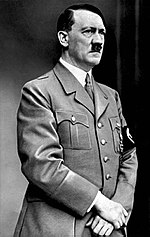German election and referendum, 1938
|
|
||||||||||||||||||||||||||||||||||
|---|---|---|---|---|---|---|---|---|---|---|---|---|---|---|---|---|---|---|---|---|---|---|---|---|---|---|---|---|---|---|---|---|---|---|
|
||||||||||||||||||||||||||||||||||
|
All 813 seats in the Reichstag 407 seats needed for a majority |
||||||||||||||||||||||||||||||||||
| Turnout | 99.50% | |||||||||||||||||||||||||||||||||
|
||||||||||||||||||||||||||||||||||
|
||||||||||||||||||||||||||||||||||
Parliamentary elections were held in Germany (including recently annexed Austria) on 10 April 1938. They were the final elections to the Reichstag during Nazi rule and took the form of a single-question referendum asking whether voters approved of a single list of Nazis and pro-Nazi "guest" candidates for the 813-member Reichstag as well as the recent annexation of Austria (the Anschluss). Turnout in the election was officially 99.5% with 98.9% voting "yes". In Austria official figures claimed 99.73% voted in favour with a turnout of 99.71%.
The elections were held largely to rally official support from the new Ostmark (Austrian) province, although further elections for 41 seats were held in the recently annexed Sudetenland on 4 December. NSDAP candidates and "guests" officially received 97.32% of the votes.
The new Reichstag, the last of the German Reich, convened for the first time on 30 January 1939, electing a presidium headed by incumbent President of the Reichstag Hermann Göring. It convened only a further seven times, the last on 26 July 1942. On 25 January 1943, Hitler postponed elections for a new Reichstag until after the war, with the inaugural to take place after another electoral term, subsequently on 30 January 1947—by which point the body, and the Nazi state, had ceased to exist.
...
Wikipedia

